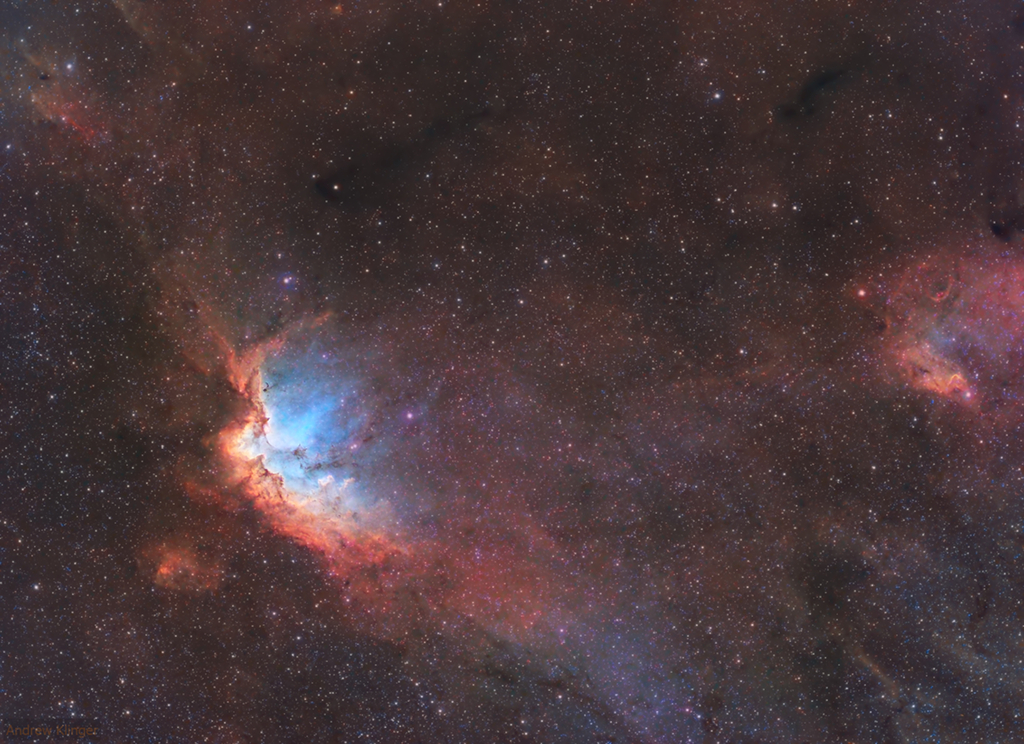Blog
Open star cluster NGC 7380 is still embedded in its natal cloud of interstellar gas and dust popularly known as the Wizard Nebula. Seen on the left, with foreground and background stars along the plane of our Milky Way galaxy it lies some 8,000 light-years distant, toward the constellation Cepheus. In apparent size on the sky, a full moon would cover the 4 million year young cluster and associated nebula, normally much too faint to be seen by eye. Made with telescope and camera firmly planted on Earth, the image reveals multi light-year sized shapes and structures of cosmic gas and dust within the Wizard though, in a color palette madepopular in Hubble Space Telescope images. Recorded with narrowband filters, the visible wavelength light from the nebula’s hydrogen, oxygen, and sulfur atoms is transformed into green, blue, and red colors in the final digital composite.

Biréli Lagrène (born 4 September 1966) is a French jazz guitarist who came to prominence in the 1980s for his Django Reinhardt–influenced style. He often performs in swing, jazz fusion, and post-bop styles.
Lagrène was born in Soufflenheim, Alsace, France, into a Romani family and community. His father and grandfather were guitarists, and he was raised in the gypsy guitar tradition. He started playing at age four or five and by seven was improvising jazz in a style similar to Django Reinhardt‘s, whom his father admired and wanted his sons to emulate. In 1980, while in his early teens, he recorded his first album, Routes to Django: Live at the Krokodil (Jazzpoint, 1981).
During the next few years, Lagrène toured with Al Di Meola, Paco de Lucía, and John McLaughlin, all of them guitarists, and played with Benny Carter, Benny Goodman, and Stéphane Grappellii. He joined Larry Coryell and Vic Juris in New York City for a tribute to Reinhardt in 1984 and went on tour with Coryell and Philip Catherine. He also performed with Jaco Pastorius, Stanley Clarke, the Gil Evans Orchestra, Christian Escoudé, and Charlie Haden. In 1989 he performed in a duo with Stanley Jordan.
more...Gene Victor Parsons (born September 4, 1944 in Morongo Valley, California) is an American drummer, banjo player, guitarist, singer-songwriter, and engineer, best known for his work with the Byrds from 1968 to 1972. Parsons has also released solo albums and played in bands including Nashville West, the Flying Burrito Brothers, and Parsons Green. Along with guitarist Clarence White, he is credited with inventing the B-Bender (also known as the StringBender)—a device which allows a guitarist to emulate the sound of a pedal steel guitar. The device is often referred to as the Parsons/White B-Bender, a trademarked name.
Gene Parsons was born on September 4, 1944 on his family’s farm in Morongo Valley in the Mojave Desert, California. His professional musical career began when he joined up with guitarist and Fiddle player Gib Guilbeau in the duo Guilbeau & Parsons. Later the duo was joined by Clarence White, former guitarist with the Kentucky Colonels, and bassist Wayne Moore to form the band Nashville West, named after a club where the band often performed.
more...
Gerald Stanley Wilson (September 4, 1918 – September 8, 2014) was an American jazz trumpeter, big band bandleader, composer, arranger, and educator. Born in Mississippi, he was based in Los Angeles from the early 1940s. In addition to being a band leader, Wilson wrote arrangements for Duke Ellington, Sarah Vaughan, Ray Charles, Julie London, Dizzy Gillespie, Ella Fitzgerald, Benny Carter, Lionel Hampton, Billie Holiday, Dinah Washington, and Nancy Wilson.
Wilson was born in Shelby, Mississippi, and at the age of 16 moved to Detroit, Michigan where he graduated from Cass Technical High School (one of his classmates was saxophonist Wardell Gray).[3] He joined the Jimmie Lunceford orchestra in 1939, replacing its trumpeter and arranger, Sy Oliver. While with Lunceford, Wilson contributed songs to the band, including “Hi Spook” and “Yard-dog Mazurka”, the first influenced by Ellington’s recording of “Caravan” and the latter an influence on Stan Kenton‘s “Intermission Riff”.
During World War II, Wilson also performed for a brief time with the U.S. Navy, with Clark Terry, Willie Smith and Jimmy Nottingham. Around 2005, many of the members of the band reunited as The Great Lakes Experience Big Band” with Wilson conducting and Ernie Andrews making a guest appearance at the invitation of Clark Terry. Wilson also played and arranged for the bands of Benny Carter, Duke Ellington, Count Basie and Dizzy Gillespie.
more...Anderson Meade Lewis (September 4, 1905 – June 7, 1964), known as Meade Lux Lewis, was an American pianist and composer, noted for his playing in the boogie-woogie style. His best-known work, “Honky Tonk Train Blues”, has been recorded by many artists.
Lewis was born in Chicago, though some sources state Louisville, Kentucky, on September 4, 1905 (September 3 and 13 have also been cited as his date of birth in various sources). In his youth he was influenced by the pianist Jimmy Yancey. His father, a guitarist who made two recordings of his own, introduced Meade to music and arranged for him to have violin lessons. He gave up the violin at age 16, shortly after his father’s death, and switched to the piano. The nickname “Lux” was given to him by his boyhood friends. He would imitate a couple of characters from a popular comic strip in Chicago, Alphonse and Gaston, and stroke an imaginary beard as part of the routine. His friends started calling him the Duke of Luxembourgbecause of this, and the name stuck for the rest of his life.
https://www.youtube.com/watch?v=FSMO0J9BLm0
more...n flamenco a tango (Spanish pronunciation: [ˈtaŋɡo]) is one of the flamenco palos closely related in form and feeling to the rumba flamenca. It is often performed as a finale to a flamenco tiento. Its compás and llamada are the same as that of the farruca and share the farruca’s lively nature. However, the tango is normally performed in the A Phrygian mode. In some English sources the flamenco tango is written with an -s; “the tangos is…”
The flamenco tango is distinct from the flamenco rumba primarily through the guitar playing. In Rumba the guitar flows more freely, whereas in Tangos the accents on beats 2, 3 & 4 are marked clearly with heavy strumming.
more...The blue and orange stars of the faint galaxy named NGC 2188 sparkle in this image taken with the NASA/ESA Hubble Space Telescope. Although NGC 2188 appears at first glance to consist solely of a narrow band of stars, it is classified by astronomers as a barred-spiral galaxy. It appears this way from our viewpoint on Earth as the centre and spiral arms of the galaxy are tilted away from us, with only the very narrow outer edge of the galaxy’s disc visible to us. Astronomers liken this occurrence to turning a dinner plate in your hands so you see only its outer edge. The true shape of the galaxy was identified by studying the distribution of the stars in the inner central bulge and outer disc and by observing the stars’ colours. NGC 2188 is estimated to be just half the size of our Milky Way, at 50 000 light-years across, and it is situated in the northern hemisphere constellation of Columba (The Dove). Named in the late 1500s after Noah’s dove in biblical stories, the small constellation consists of many faint yet beautiful stars and astronomical objects.

Dorothy Masuka (3 September 1935, in Bulawayo, Southern Rhodesia (now Zimbabwe) – 23 February 2019, in Johannesburg, South Africa) was a Zimbabwe-born South African jazz singer. On the 23rd of February 2019, she succumbed to stroke in South Africa
She was born in Bulawayo, the fourth of seven children, and her mother was a Zulu woman while her father was a Zambian hotel chef. Still, she attended a Catholic school deemed good by the standards of education allowed to black people. Her family moved to South Africa when she was 12 due to her health. By the time she was 19 she was touring in South Africa with singers she had admired as a girl.
more...Fred “Freddie” King (September 3, 1934 – December 28, 1976) was an American blues guitarist and singer. He recorded several hits for Federal Records in the early 1960s. His soulful and powerful voice and distinctive guitar style inspired many musicians, particularly guitarists. He was inducted into the Rock and Roll Hall of Fame in 2012.
King based his guitar style on Texas blues and Chicago blues influences. His best-known recordings include the early instrumentals “Hide Away” (1961), “San-Ho-Zay,” (1961) and “The Stumble” (1962). The album Freddy King Sings showcased his singing talents and included the record chart hits “You’ve Got to Love Her with a Feeling” and “I’m Tore Down”. He later became involved with more rhythm and blues– and rock-oriented producers and was one of the first bluesmen to have a multiracial backing band at live performances.
According to his birth certificate he was named Fred King, and his parents were Ella Mae King and J. T. Christian. When Freddie was six years old, his mother and his uncle began teaching him to play the guitar. In autumn 1949, he and his family moved from Dallas to the South Side of Chicago.
In 1952 King started working in a steel mill. In the same year he married another Texas native, Jessie Burnett. They had seven children.
more...Granville William “Mickey” Roker (September 3, 1932 – May 22, 2017) was an American jazz drummer.
Roker was born into extreme poverty in Miami to Granville (Sr.) and Willie Mae Roker. After his mother died (his father never lived with them), when he was only ten, he was taken by his grandmother to live in Philadelphia with his uncle Walter, who gave him his first drum kit and communicated his love of jazz to his nephew. He also introduced the young Roker to the jazz scene in Philadelphia, where drummer Philly Joe Jones became Roker’s idol.
In the early 1950s, he began to gain recognition as a sensitive yet hard-driving big-band drummer. He was especially favored by Dizzy Gillespie, who remarked of him that “once he sets a groove, whatever it is, you can go to Paris and come back and it’s right there. You never have to worry about it.” Roker was soon in demand for his supportive skills in both big-band and small-group settings.
While in Philadelphia he played with Jimmy Oliver, Jimmy Heath, Jimmy Divine, King James and Sam Reed before moving to New York in 1959, where his first gigs were with Gigi Gryce, Ray Bryant, Joe Williams, Junior Mance, Nancy Wilson and the Duke Pearson big band. In 1965 Mickey joined Art Farmer and Benny Golson’s revamped group, the “New York Jazz Sextet”. In 1992, he replaced Connie Kay in the Modern Jazz Quartet.
He recorded with Dizzy Gillespie, Sonny Rollins, Duke Pearson, Tommy Flanagan, Ella Fitzgerald, Zoot Sims, Horace Silver, Junior Mance, Sarah Vaughan, Milt Jackson, Herbie Hancock, Phil Woods, Oscar Peterson, Ray Brown, Bucky Pizzarelli, Stanley Turrentine, Toshiko Akiyoshi, Hank Jones, Bobby Hutcherson, Joe Locke, and many other jazz musicians.
more...Shoista Mullojonova (Tajik: Шоиста Муллоҷонова, Persian: شایسته ملاجانآوا, Russian: Шоиста Рубиновна Муллоджанова; September 3, 1925 – June 26, 2010), born Shushana Rubinovna Mullodzhanova, was a renowned Tajik-born Bukharian Jewish Shashmakom singer.
She was born in Dushanbe, Tajik ASSR to a religious Bukharian Jewish family. Her mother, Sivyo Davydova, was from Samarkand and her father, Rubin Mullodzhanov, originally came from Bukhara. Her family traces its ancestry to an artistocratic Levite tribe that has been into performing and entertaining since the time of the First and Second Temple in Jerusalem.
Her family was full of entertainers (actors, singers, and musicians).[citation needed] In 1924, her parents and older siblings (Ribi, Levi, Ishokhor, Roza, Zulai) moved from Uzbekistan to Tajikistan, where Shoista was born a year later. She learned to speak fluent Bukhori, a dialect of the Tajiki-Persian language, and Russian. Her mother was also a singer and her whole family was into music and acting. She graduated from the Stalinabad Women’s Pedagogical School in 1943 and studied at the Moscow Conservatory from 1947 to 1953.
more...Memphis Slim (born John Len Chatman, September 3, 1915 – February 24, 1988) was an American blues pianist, singer, and composer. He led a series of bands that, reflecting the popular appeal of jump blues, included saxophones, bass, drums, and piano. A song he first cut in 1947, “Every Day I Have the Blues“, has become a blues standard, recorded by many other artists. He made over 500 recordings. He was posthumously inducted into the Blues Hall of Fame in 1989.
Memphis Slim was born John Len Chatman, in Memphis, Tennessee. For his first recordings, for Okeh Records in 1940, he used the name of his father, Peter Chatman (who sang, played piano and guitar, and operated juke joints); it is commonly believed that he did so to honor his father. He started performing under the name “Memphis Slim” later that year but continued to publish songs under the name Peter Chatman.
He spent most of the 1930s performing in honky-tonks, dance halls, and gambling joints in West Memphis, Arkansas, and southeast Missouri. He settled in Chicago in 1939 and began teaming with the guitarist and singer Big Bill Broonzy in clubs soon afterwards. In 1940 and 1941 he recorded two songs for Bluebird Records that became part of his repertoire for decades, “Beer Drinking Woman” and “Grinder Man Blues”. These were released under the name “Memphis Slim,” given to him by Bluebird’s producer, Lester Melrose.[6]Slim became a regular session musician for Bluebird, and his piano talents supported established stars such as John Lee “Sonny Boy” Williamson, Washboard Sam, and Jazz Gillum. Many of Slim’s recordings and performances until the mid-1940s were with Broonzy, who had recruited Slim to be his piano player after the death of his accompanist Joshua Altheimer in 1940.
more...While appearing as a delicate and light veil draped across the sky, this image from the NASA/ESA Hubble Space Telescope actually depicts a small section of the Cygnus supernova blast wave, located around 2,400 light-years away. The name of the supernova remnant comes from its position in the northern constellation of Cygnus (the Swan), where it covers an area 36 times larger than the full Moon.
The original supernova explosion blasted apart a dying star about 20 times more massive than our Sun between 10,000 and 20,000 years ago. Since then, the remnant has expanded 60 light-years from its center. The shockwave marks the outer edge of the supernova remnant and continues to expand at around 220 miles per second. The interaction of the ejected material and the low-density interstellar material swept up by the shockwave forms the distinctive veil-like structure seen in this image.

William Everett Preston (September 2, 1946 – June 6, 2006) was an American musician whose work encompassed R&B, rock, soul, funk, and gospel. Preston was a top session keyboardist in the 1960s, during which he backed artists such as Little Richard, Sam Cooke, Ray Charles, Everly Brothers, Reverend James Cleveland, and the Beatles. He went on to achieve fame as a solo artist with hit singles such as “That’s the Way God Planned It“, the Grammy-winning “Outa-Space“, “Will It Go Round in Circles“, “Space Race“, “Nothing from Nothing“, and “With You I’m Born Again“. Additionally, Preston co-wrote “You Are So Beautiful“, which became a #5 hit for Joe Cocker.
Preston was one of five musicians credited on a Beatles recording other than the group’s four members. Preston continued to record and perform with other artists, notably George Harrison after the Beatles’ breakup, and Eric Clapton, and he played keyboards for the Rolling Stones on many of the group’s albums and tours during the 1970s.
Preston was born September 2, 1946, in Houston and moved to Los Angeles as a child with his mother, Robbie Lee Williams. Noted as a child prodigy, Preston was entirely self-taught and never had a music lesson. By the age of ten, he was playing organ onstage backing several gospel singers such as Mahalia Jackson. At 11, Preston appeared on an episode of Nat King Cole‘s NBC TV show singing the Fats Domino hit “Blueberry Hill” with Cole. He also appeared in St. Louis Blues, the 1958 W. C. Handy biopic starring Nat King Cole; Preston played Handy at a younger age.
more...Laurindo Almeida (September 2, 1917 – July 26, 1995) was a Brazilian guitarist and composer in classical, jazz, and Latin music. He and Bud Shankwere pioneers in the creation of bossa nova. Almeida was the first guitarist to receive Grammy Awards for both classical and jazz performances. His discography encompasses more than a hundred recordings over five decades.
Laurindo Jose de Araujo Almeida Nobrega Neto was born in the village of Prainha, Brazil near Santos in the state of São Paulo.
Born into a musical family, Almeida was a self-taught guitarist. During his teenage years, Almeida moved to São Paulo, where he worked as a radio artist, staff arranger and nightclub performer. At the age of 19, he worked his way to Europe playing guitar in a cruise ship orchestra. In Paris, he attended a performance at the Hot Club by Stephane Grappelli and famed guitarist Django Reinhardt, who became a lifelong artistic inspiration.
more...More Posts
- RENT the musical 2-8-23 7pm
- Cosmos RCW 58
- Tom Rush
- John Williams
- Eddie Locke
- Lonnie Johnson
- World Music Debashish Bhattacharya
- Daily Roots Prince Far I
- Cosmos Comet ZTF
- Laurie Johnson
- Milt Holland
- King Curtis
- Earl King
- Eubie Blake
- World Music The Malfoof Collective
- Daily Roots Vibes Tone
- Bob Marley Day 2023
- Cosmos NGC 4303
- Natalie Cole
- Calvin Keys